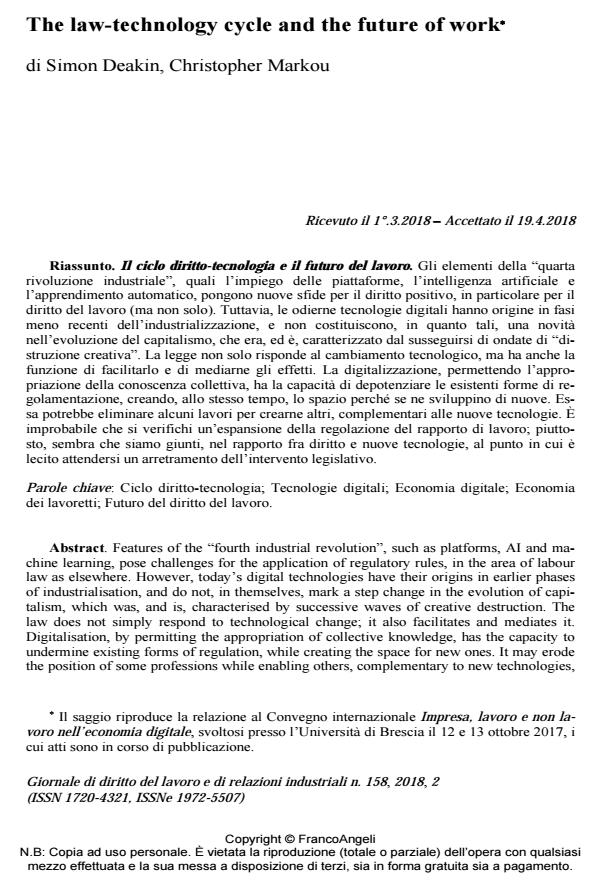The law-technology cycle and the future of work
Titolo Rivista GIORNALE DI DIRITTO DEL LAVORO E DI RELAZIONI INDUSTRIALI
Autori/Curatori Simon Deakin, Christopher Markou
Anno di pubblicazione 2018 Fascicolo 2018/158
Lingua Inglese Numero pagine 18 P. 445-462 Dimensione file 232 KB
DOI 10.3280/GDL2018-158009
Il DOI è il codice a barre della proprietà intellettuale: per saperne di più
clicca qui
Qui sotto puoi vedere in anteprima la prima pagina di questo articolo.
Se questo articolo ti interessa, lo puoi acquistare (e scaricare in formato pdf) seguendo le facili indicazioni per acquistare il download credit. Acquista Download Credits per scaricare questo Articolo in formato PDF

FrancoAngeli è membro della Publishers International Linking Association, Inc (PILA)associazione indipendente e non profit per facilitare (attraverso i servizi tecnologici implementati da CrossRef.org) l’accesso degli studiosi ai contenuti digitali nelle pubblicazioni professionali e scientifiche
Features of the "fourth industrial revolution", such as platforms, AI and machine learning, pose challenges for the application of regulatory rules, in the area of labour law as elsewhere. However, today’s digital technologies have their origins in earlier phases of industrialisation, and do not, in themselves, mark a step change in the evolution of capitalism, which was, and is, characterised by successive waves of creative destruction. The law does not simply respond to technological change; it also facilitates and mediates it. Digitalisation, by permitting the appropriation of collective knowledge, has the capacity to undermine existing forms of regulation, while creating the space for new ones. It may erode the position of some professions while enabling others, complementary to new technologies, to emerge. It is unlikely to bring about the redundancy of forms of labour law regulation centred on the employment relationship. We appear to reaching a point in the law-technology cycle where push-back against regulatory arbitrage can be expected.
Gli elementi della "quarta rivoluzione industriale", quali l’impiego delle piattaforme, l’intelligenza artificiale e l’apprendimento automatico, pongono nuove sfide per il diritto positivo, in particolare per il diritto del lavoro (ma non solo). Tuttavia, le odierne tecnologie digitali hanno origine in fasi meno recenti dell’industrializzazione, e non costituiscono, in quanto tali, una novità nell’evoluzione del capitalismo, che era, ed è, caratterizzato dal susseguirsi di ondate di "distruzione creativa". La legge non solo risponde al cambiamento tecnologico, ma ha anche la funzione di facilitarlo e di mediarne gli effetti. La digitalizzazione, permettendo l’appro¬priazione della conoscenza collettiva, ha la capacità di depotenziare le esistenti forme di regolamentazione, creando, allo stesso tempo, lo spazio perché se ne sviluppino di nuove. Essa potrebbe eliminare alcuni lavori per crearne altri, complementari alle nuove tecnologie. È improbabile che si verifichi un’espansione della regolazione del rapporto di lavoro; piuttosto, sembra che siamo giunti, nel rapporto fra diritto e nuove tecnologie, al punto in cui è lecito attendersi un arretramento dell’intervento legislativo.
Parole chiave:Ciclo diritto-tecnologia; Tecnologie digitali; Economia digitale; Economia dei lavoretti; Futuro del diritto del lavoro.
Simon Deakin, Christopher Markou, The law-technology cycle and the future of work in "GIORNALE DI DIRITTO DEL LAVORO E DI RELAZIONI INDUSTRIALI " 158/2018, pp 445-462, DOI: 10.3280/GDL2018-158009